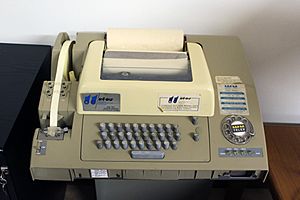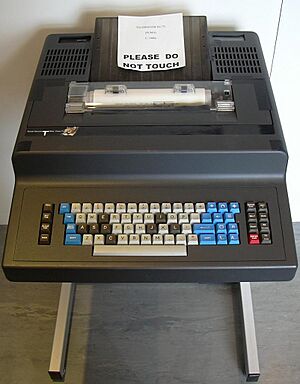Telex facts for kids
Imagine a time before the internet, email, or even fax machines! That's when Telex was a super important way to send text messages over long distances. It was a special system that let people send typed messages using machines called teleprinters. These teleprinters connected through telephone lines, but they were different from regular phones. Telex was a big deal for businesses and governments, especially after World War II. It helped people communicate quickly across cities and even countries. However, as new technologies like fax machines came along in the 1980s, Telex started to be used less and less.
Contents
How Telex Messages Were Sent
Telex worked by connecting two special typing machines, called teleprinters. One machine would send a message, and the other would receive and print it. These machines used telephone lines, but they had their own special way of sending information. Unlike voice calls, which send sounds, Telex sent text using simple electrical signals.
To save time and money, people often typed their messages onto a paper tape first. This tape had holes punched in it, representing the letters. Once the message was ready on the tape, it could be sent very quickly. The receiving machine would then print out the message. This system allowed businesses to send important documents and messages all over the world.
The Story of Telex: From Germany to the World
The idea for Telex started in Germany in 1926. By 1933, it became a working service for sending messages. It quickly spread across Europe and then to many other parts of the world after 1945.
Telex was very important for international communication. Even in places without good telephone systems, people used special radio links to send Telex messages. This allowed governments and businesses to stay connected globally.
Telex was like an early version of today's fax, email, and even text messaging. Did you know that abbreviations like "CU L8R" (see you later) might have started with Telex operators? They used these shortcuts to chat quickly while sending messages. Just like email today, Telex also allowed people to send one message to many different places at the same time.
Sending and Receiving Messages
To send a Telex message, you needed a special address, like "14910 ERIC S". This address included a subscriber number, a short name for the company, and a country code. It was similar to how we use email addresses or phone numbers today.
One cool feature of Telex was called "answerback." When you started sending a message, your machine would ask "Who are you?" (WRU). The other machine would automatically send back a special code. This code confirmed that you were connected to the right person and that the connection was working. It was a great way to make sure your important message reached its intended recipient.
People often prepared their messages beforehand on paper tape. This made sending the message very fast, which saved money because you paid for how long you were connected. You could also type messages in "real-time," where both people could type and see the text appear instantly on the other machine.
Telex was even used to send information between early computer systems. It was a basic form of electronic data interchange, helping different systems share data before the internet made it easy.
Telex Around the World
Many countries adopted Telex and built their own networks. It became a global standard for sending text messages between businesses and organizations.
Telex in the United States
In the United States, a service called Teletypewriter Exchange Service (TWX) started in 1931. Later, Western Union also built a large Telex network across the country. These services allowed people to send messages to other Telex machines both locally and internationally.
Telex in the United Kingdom
The United Kingdom also developed its Telex service, starting in the 1930s. By 1961, it had an automatic system with many exchanges across the country. Companies like Creed & Company made the Telex machines used there.
Telex in Canada
Canada introduced its own country-wide Telex service in 1957. This allowed Canadian users to connect with people in Europe, Latin America, Africa, and other parts of the world.
Why Telex Faded Away
Even though Telex was very important for many years, its use started to decline. Newer technologies like fax machines, email, and text messaging became more popular. These new ways of communicating were often faster, easier, and cheaper.
Today, Telex is mostly replaced by these modern systems. However, a version called radiotelex (Telex over radio) is still used in the shipping industry. It's an important part of the Global Maritime Distress and Safety System for safety at sea.
See also
- Dot matrix printing
- Morse code
- Telegraphy
- Text messaging
- Ticker tape
- Worldwide use of telegrams by country
- Faxhe:טלגרפיה#טלקס



